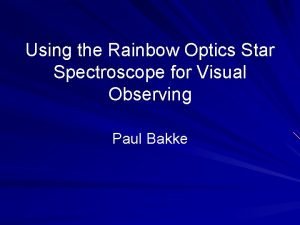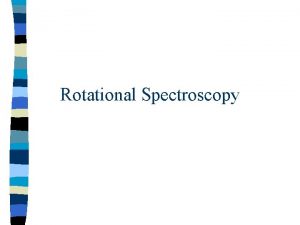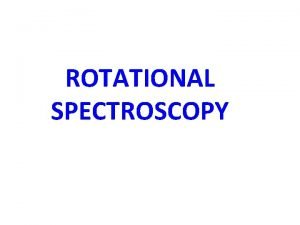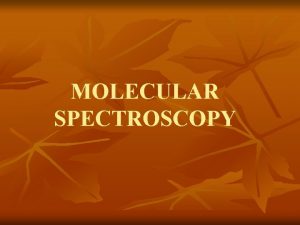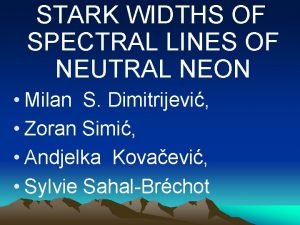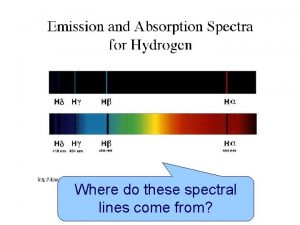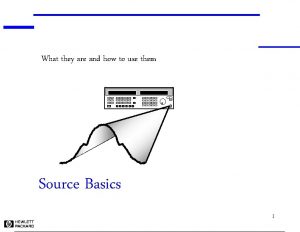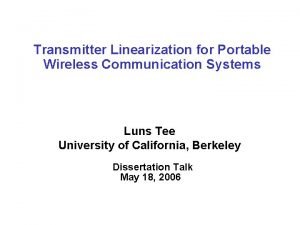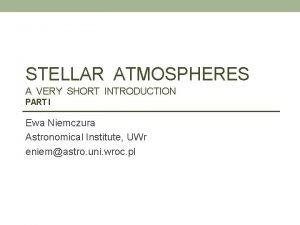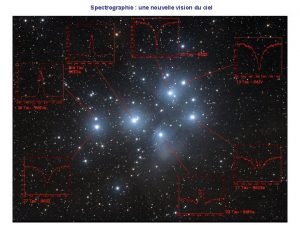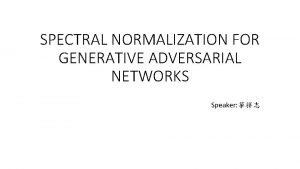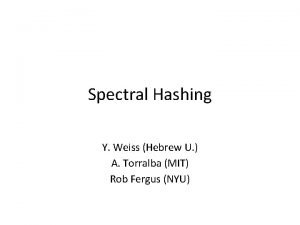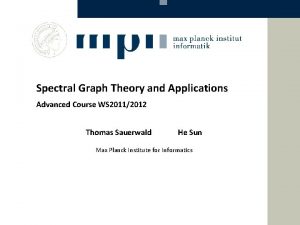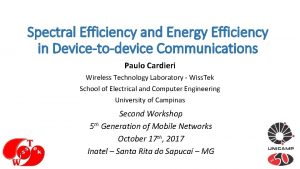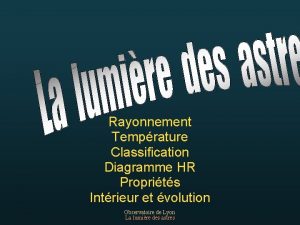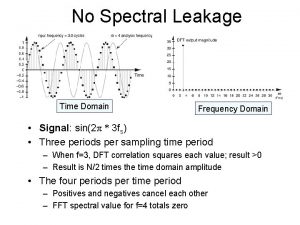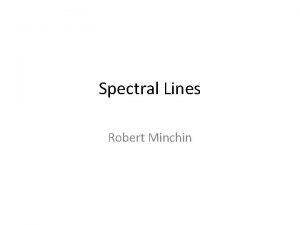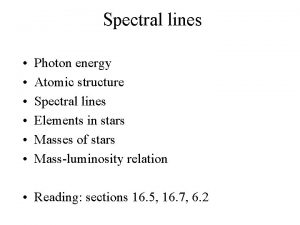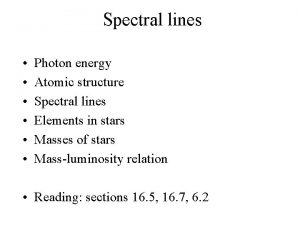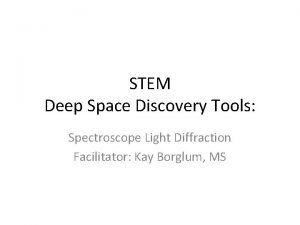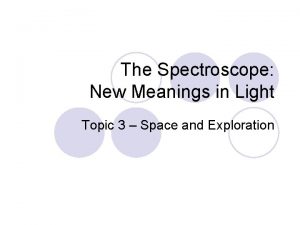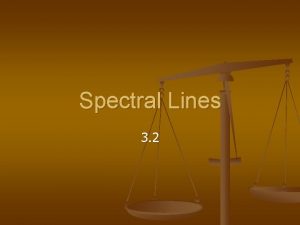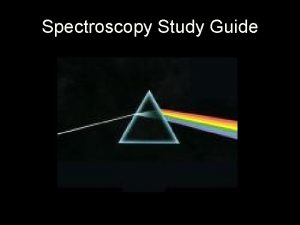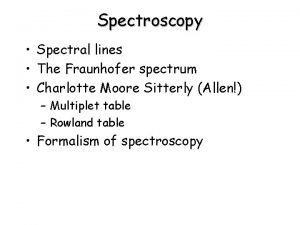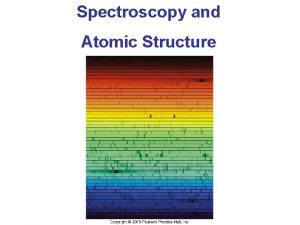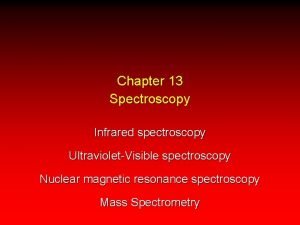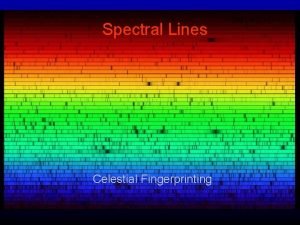Chapter 4 Spectroscopy Spectral Lines Spectroscope Splits light






















- Slides: 22

Chapter 4 Spectroscopy

Spectral Lines Spectroscope: Splits light into component colors

Spectral Lines Emission lines: Single frequencies emitted by particular atoms

Spectral Lines Emission spectrum can be used to identify elements

Spectral Lines Absorption spectrum: If a continuous spectrum passes through a cool gas, atoms of the gas will absorb the same frequencies they emit Appear like bar codes

Spectral Lines Absorption spectrum can identify elements Emission and absorption spectra of sodium

Spectral Lines Kirchhoff’s Laws: • Luminous solid, liquid, or dense gas produces continuous spectrum • Low-density hot gas produces emission spectrum • Continuous spectrum incident on cool, thin gas produces absorption spectrum

Spectral Lines Kirchhoff’s laws illustrated:

Atoms and Radiation Spectral lines required new model of atom Only certain amounts of energy could be emitted or absorbed Bohr model had certain allowed orbits for electron

Atoms and Radiation Emission energies correspond to energy differences between allowed levels Modern model has electron “cloud” rather than orbit

Atoms and Radiation Energy levels of the hydrogen atom, showing two series of emission lines: Energy levels given by: Emission lines correspond to the energy differences

Atoms and Radiation The photoelectric effect: When light shines on metal, electrons can be emitted Frequency must be higher than minimum, characteristic of material Increased frequency—more energetic electrons Increased intensity—more electrons, same energy

Atoms and Radiation Photoelectric effect can only be understood if light behaves like particles

Atoms and Radiation Light particles each have energy E: Here, h is Planck’s constant:

Formation of Spectral Lines Absorption can boost an electron to the second (or higher) excited state Two ways to decay: 1. To ground state 2. Cascade one orbital at a time

Formation of Spectral Lines Absorption spectrum: Created when atoms absorb photons of right energy for excitation

Formation of Spectral Lines Emission lines can be used to identify atoms

Molecules can vibrate and rotate, besides having energy levels • Electron transitions produce visible and ultraviolet lines • Vibrational transitions produce infrared lines • Rotational transitions produce radio-wave lines

Spectral-Line Analysis Information that can be gleaned from spectral lines: • Chemical composition • Temperature • Radial velocity

Spectral-Line Analysis The Doppler shift may cause thermal broadening of spectral lines

Spectral-Line Analysis Rotation will also cause broadening of spectral lines through the Doppler effect

Assignment Time • Chapter 4 R&D • Questions 1, 3, 4, 5, 6, 12, 13, 19, 20
 Rainbow optics star spectroscope
Rainbow optics star spectroscope Light light light chapter 23
Light light light chapter 23 Light light light chapter 22
Light light light chapter 22 Chapter 22
Chapter 22 Asymmetric top molecules examples
Asymmetric top molecules examples Application of rotational spectroscopy
Application of rotational spectroscopy Factors affecting width and intensity of spectral lines
Factors affecting width and intensity of spectral lines Neon spectral lines
Neon spectral lines Atomic spectral lines
Atomic spectral lines The bone is bent and splits causing an incomplete break.
The bone is bent and splits causing an incomplete break. Check defect in timber
Check defect in timber The nation splits
The nation splits Spectral regrowth
Spectral regrowth Spectral regrowth
Spectral regrowth Spectral classification
Spectral classification Profil spectral de rigel
Profil spectral de rigel Spectral normalization for generative adversarial networks
Spectral normalization for generative adversarial networks Hashing
Hashing A brief introduction to spectral graph theory
A brief introduction to spectral graph theory Spectral efficiency
Spectral efficiency Domaine spectral
Domaine spectral Spectral leakage
Spectral leakage Spectral bands
Spectral bands
